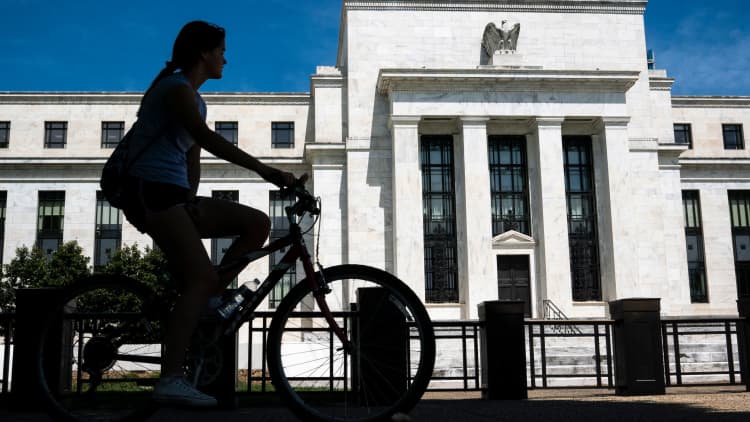
In an extraordinary move, the Federal Reserve announced announced it is dropping its benchmark interest rate to zero in response to the growing threat from the coronavirus outbreak.
The Fed "is prepared to use its full range of tools to support the flow of credit to households and businesses," the central bank said in a statement.
The Fed also said it "expects to maintain this target range until it is confident that the economy has weathered recent events."
Interest rates are now historically low, which leaves the central bank very little wiggle room if the economy stumbles further.
"The Fed cut the benchmark interest rate back to the 0% to 0.25% range first enacted during the financial crisis and prevailed for the next seven years," said Greg McBride, chief financial analyst at Bankrate.com.

Although the federal funds rate, which is what banks charge one another for short-term borrowing, is not the rate that consumers pay, the Fed's moves still affect the borrowing and saving rates they see every day.
"Reducing interest rates to borrowers will ease the burden of existing debts slightly but is unlikely to spur the usual surge of borrowing as consumers and businesses batten down the hatches for a coming drop off in U.S. economic activity," McBride said.
Here's a breakdown of how it works:
Credit cards
Most credit cards come with a variable rate, which means there's a direct connection to the Fed's benchmark rate.
With a rate cut, the prime rate lowers, too, and credit cards likely will follow suit. For cardholders, that means they could see that reduction in their annual percentage yield, or APR, within a billing cycle or two.
"For someone with $6,000 in credit card debt, today's move alone can end up saving them a little less than $200 in interest," said Matt Schulz, chief industry analyst at CompareCards.com.
"That may not change people's lives, but it is a significant savings."
On the heels of the previous rate moves, credit card rates are down only slightly from a high of 17.85% when the Fed started cutting rates last July, according to Bankrate.
Student loans
Most student borrowers rely on federal student loans, which are fixed — for now. The Fed's action will cause those rates to fall.
The rate on undergraduate Stafford loans is currently 4.5% for the 2019-2020 academic year, however all federal education loans issued for 2020-2021 will be subject to new rates.
The government sets annual rates on those loans once a year, based on the 10-year Treasury note.
If the 10-year yield stays below 1%, federal student loan interest rates could drop significantly when they reset — saving borrowers hundreds of dollars in interest.
More from Personal Finance:
How to build a cash reserve if the coronavirus disrupts your job
How to manage your 401(k) as the coronavirus upends markets
Avoid this investing mistake as coronavirus fears grip markets
Another 1.4 million students a year use private student loans to bridge the gap between the cost of college and their financial aid and savings.
Private loans may be fixed or may have a variable rate tied to Libor, prime or T-bill rates, which means that when the Fed cuts rates, borrowers will pay less in interest, although how much less will vary by the benchmark and the terms of the loan.
If you have a mix of federal and private student loans, consider prioritizing paying off your private loans first or refinance your private loans to lock in a lower fixed rate if possible.
Savings
As a result of preceding changes in interest rates, savings rates — the annual percentage yield banks pay consumers on their money — are now as high as 2%, up from 0.1%, on average, before the Federal Reserve started increasing its benchmark rate in 2015.
With the Fed's benchmark rate back to essentially zero, those recent gains in savings rates will erode immediately.
Already, according to the FDIC, the average savings account rate is a mere 0.09% or even less at some of the largest retail banks. However, nline banks pay 10 times or 20 times that because they have fewer overhead expenses than traditional brick-and-mortar banks.
Consumers should aim to secure a deposit rate that at least beats inflation, according to Richard Barrington, a financial expert at MoneyRates.com.
Alternatively, lock in a higher rate with a one-, three- or five-year certificate of deposit although that money isn't as accessible as it is in a savings account and, for that reason, does not work well as an emergency fund.
Mortgages
The economy, the Fed and inflation all have some influence over long-term fixed mortgage rates, which generally are pegged to yields on U.S. Treasury notes.
As a result, mortgage rates are already substantially lower since the end of last year.
That means that if you bought a house last year, you may want to consider refinancing at a lower rate.
Many homeowners with adjustable-rate mortgages, which are pegged to a variety of indexes such as the prime rate, Libor or the 11th District Cost of Funds, may see their interest rate go down as well, although not immediately as ARMs generally reset just once a year.
This is better news for consumers with home equity lines of credit, according to Holden Lewis, NerdWallet's home expert.
Auto loans
For those planning on purchasing a new car, the Fed decision likely will not have any big material effect on what you pay.
Auto loan rates are still relatively low, even after years of rate hikes. The average interest rate on auto loans is 5.7%, according to Edmunds. Separate research from WalletHub shows that the best rates are snagged through manufacturer financing (34% below average).
However, since new cars are often financed by car manufacturers, these low rates will lower their costs, as well, and could mean car shoppers will be able to negotiate more successfully, according Tendayi Kapfidze, chief economist at LendingTree, an online loan marketplace.



